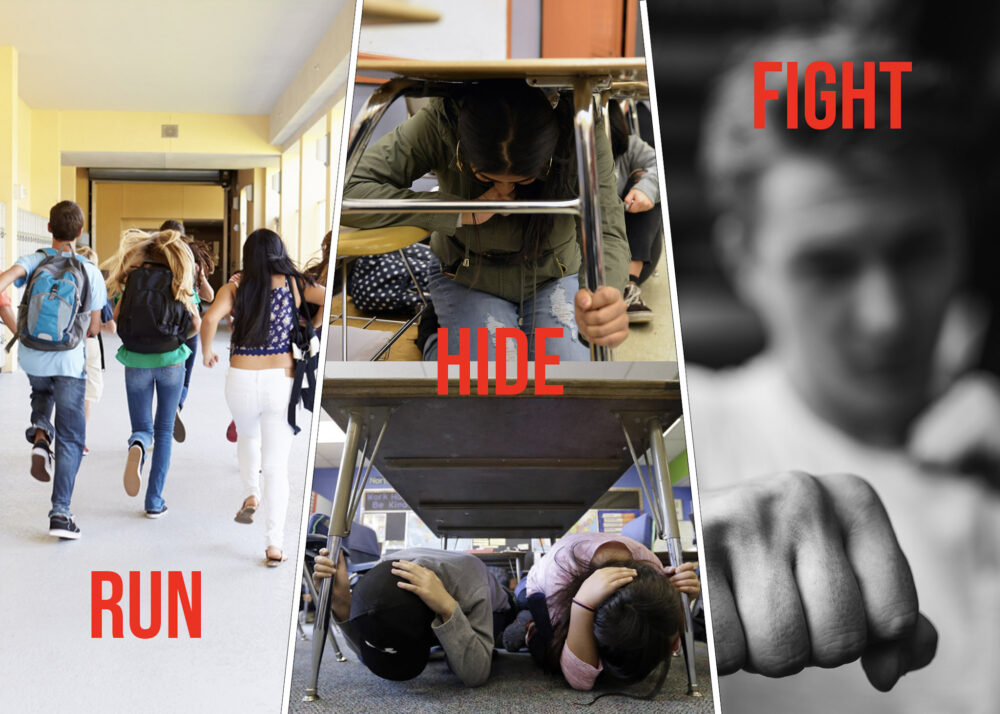
By Cate Meister
In the wake of the fatal school shooting on Nov. 30 in Oxford, Michigan, schools across the nation have begun reevaluating their own safety plans regarding active shooters. Fountain Valley High School (FVHS), however, has not made any modifications to its current plan, opting instead to maintain its “run, hide, fight” strategy in conjunction with other measures.
“Run, hide, fight” refers to the steps students are advised to take in the case of an active shooter on campus–first running away, then hiding and lastly fighting when given no other option. The policy is designed to be used as a last resort during immediate danger; the school will initiate a lock down in most situations before these measures are needed.
The safety policy, which is delineated in FVHS’s “Smart Start” presentation given to students at the beginning of the year, also includes a variety of communication methods.
“We use a series of communication [methods], so that would be through both Parent Square email or our loudspeaker and then Titan HST which is, I think, the most reliable way right now to communicate with staff and students,” Assistant Principal of Supervision and Athletics Elliot Skolnick said.
But a larger and equally important aspect of school safety comes from prevention. Preventative measures have become an area of focus after incidents prior to the Michigan shooting indicating potential violence received little action from the school.
FVHS has implemented a system that relies on threat assessments conducted by school psychologists. A student perceived as a threat who has been reported to administration will undergo an assessment to determine whether or not the student poses a genuine safety concern.
“[School psychologist Cynthia] Olaya…actually trains people from both our district and other districts on the process of doing a threat assessment on students,” Skolnick said.
Any student deemed a legitimate threat to campus safety through this process is immediately sent home.
“A threat assessment can be thought of as a three-pronged, interdisciplinary process: a mental health interview, a school investigation and a law enforcement investigation,” Olaya said.
As school psychologist, Olaya conducts the mental health portion of this process, looking for “Common Themes that Elicit Concern,” a system coined by the US Department of Education.
The campus is also equipped with a Student Resource Officer (SRO) from the Fountain Valley Police Department (FVPD), who serves as a liaison between FVHS and the surrounding community. SROs can report any outside information directly to the school.
Skolnick also said that in the case of a threat, FVPD would be immediately notified, much like earlier this year when an invalid shooter threat caused the cancellation of the Aloha Dance.
In terms of repercussions, any student in possession of a firearm (or other weapons) on campus will be immediately suspended for five days. From there, the school recommends the student for expulsion, and a panel of administrators across the district determines the future enrollment status of the student.
Ultimately, the system is highly reliant on reports from students, teachers and staff since administrators often do not witness suspicious or concerning behaviors in students first hand. Students can contact administration via the anonymous hotline (which is listed on the back of FVHS student ID cards) or Titan HST. In emergencies, students can dial “311” on any school phone.
“The most important thing is, if you look at most school shootings, someone knew something. I’m not saying they knew everything, but most people don’t do this in isolation,” Skolnick said. “If people have an idea that something may happen even if they’re wrong, let somebody know.”
Olaya also echoed Scolnick’s sentiments.
“Students should be aware of anything that seems concerning, out of place or unusual,” Olaya said. “FVHS is a very safe place, partly because students speak up when they have a concern.”





